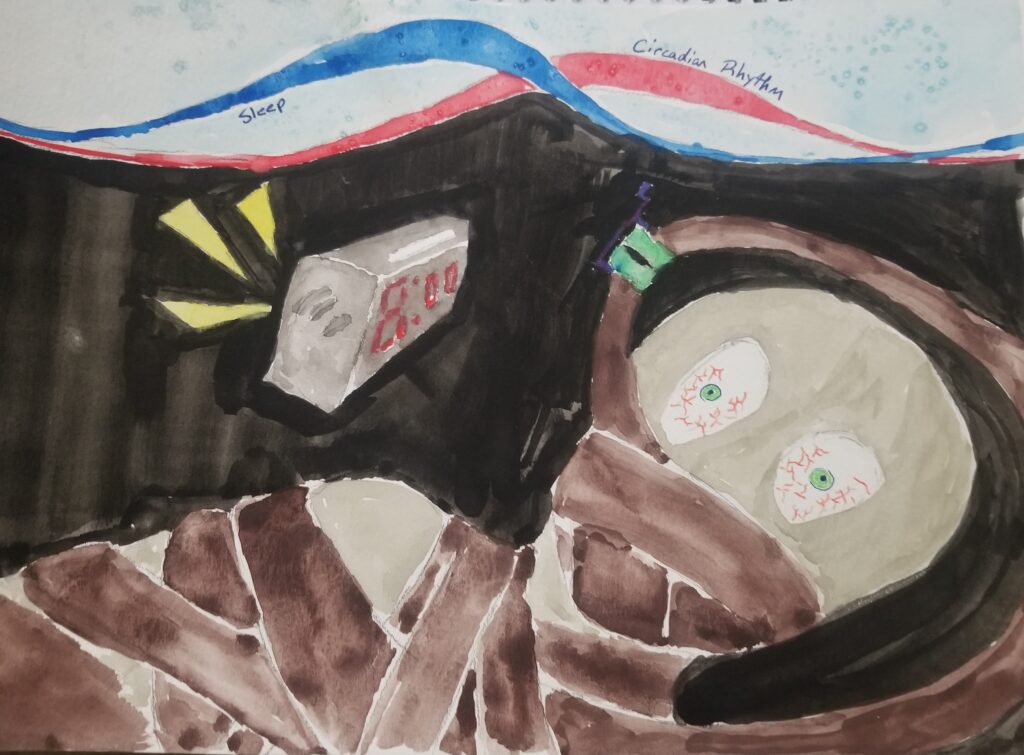
Malfunctioning Circadian Rhythms from a Sleep Paralysis Perspective
I have chosen to use watercolor paints to accomplish my STEAM project. This is supposed to assist the viewer in understanding the basics of how sleep paralysis works from the viewpoint of a person suffering from it. It is my hope that it gets across the dread and fear that is often associated with sleep paralysis as well as show how it is likely a result of an offset circadian rhythm. A person suffering from sleep paralysis will often experience hallucinations and are aware of their environment, hence the wide terrified eyes (Denis et al., 2018; Jalal, 2018). The objective that I am relating this project to is unit 5’s “Explain the adaptive importance of rhythmic activity, both circadian and circannual”. This importance is shown by diving into what can happen if one of our most regular rhythms is off by even a small amount.
Normally sleep is meant to be a relaxing period which helps in sorting through the day’s events, deal with stress and even maintain important biological functions. Someone suffering from sleep paralysis, however, might dread the action of going to sleep or even waking up, and it is an affliction that approximately 7.6% of the global population has experienced at least once (Wróbel-Knybel et al., 2022). Normal REM paralysis during sleep occurs through the utilization of metabotropic and ionotropic gamma-aminobutyric acid (GABAA and GABAB) receptors along with glycine receptors to shut down motor neuron activity (Brooks et al., 2012). This is important because during REM sleep the central nervous system (CNS) is normally very active and could otherwise send successful signals for movement (Brooks et al., 2012).
These GABA neurotransmitters follow a circadian pattern. If someone’s circadian rhythm is offset, these inhibitory neurotransmitters may start to take affect a little too early or last a little too long, leaving the sufferer unable to move but otherwise retains respiratory and ocular function, resulting what we call sleep paralysis (Dennis et al., 2018). Though we don’t have an exact cause as to why this happens, studies have been done looking into genetic, social, and behavioral causes for this affliction. Genetically, an important gene in establishing and maintaining a circadian clock is PER2 (Dennis et al., 2015; Kim, M. et al., 2018). PER2 regulates the release of many neurotransmitters including GABA and in a study performed by Dennis et al., they found an association between one genotype of PER2 and sleep paralysis that was significant. PER2 is only one of many clock genes and other genes were not explored in their study, but they did find that sleep paralysis was a moderately heritable trait (Denis et al., 2015). Behaviorally, fatigue and alcohol intake were among the most significantly associated to sleep paralysis (Dennis et al., 2015; Jalal et al., 2013; Wróbel-Knybel et al., 2022).
Though most sleep paralysis cases are not associated with any major pathologies, it can still affect quality of life, be associated with smaller chronic pathologies, and can be accompanied by serious comorbidities (Jalal, 2018). Sleep paralysis is, itself, considered a comorbidity of narcolepsy and hypertension, and people who suffer from sleep paralysis are at 2.0 greater odds of experiencing violent behavior during sleep than someone who does not suffer from sleep paralysis (Denis et al., 2018; Ohayon et al., 2010; Sharpless et al., 2011).
Considering the many avenues that sleep paralysis can be experienced, more effort should be put to understanding it. It is a condition that is broadly a result of a person’s circadian rhythm not matching up with their body’s signals which can be valuable for further circadian cycle research. Though this paper largely placed an emphasis on the involvement of the PER2 clock gene, other clock genes also likely are involved with sleep paralysis. Gaining a more complete understanding of the entire genetic map for how the clock genes influence sleep paralysis could alleviate constant fear and anxiety for people who suffer chronically from sleep paralysis. This relief can lead to a better quality of life, less stress on the sufferer, and alleviate ailments associated with prolonged stress which is caused by a slightly late or early circadian rhythm.
Sources:
Brooks, P. L., & Peever, J. H. (2012). Identification of the transmitter and receptor mechanisms responsible for REM sleep paralysis. Journal of Neuroscience, 32(29), 9785–9795. https://doi.org/10.1523/jneurosci.0482-12.2012
Denis, D., French, C. C., & Gregory, A. M. (2018). A systematic review of variables associated with sleep paralysis. Sleep Medicine Reviews, 38, 141–157. https://doi.org/10.1016/j.smrv.2017.05.005
Denis, D., French, C. C., Rowe, R., Zavos, H. M., Nolan, P. M., Parsons, M. J., & Gregory, A. M. (2015). A Twin and molecular genetics study of sleep paralysis and associated factors. Journal of Sleep Research, 24(4), 438–446. https://doi.org/10.1111/jsr.12282
Jalal, B. (2018). The neuropharmacology of sleep paralysis hallucinations: serotonin 2A activation and a novel therapeutic drug. Psychopharmacology, 235(11), 3083–3091. https://doi.org/10.1007/s00213-018-5042-1
Jalal, B., Simons-Rudolph, J., Jalal, B., & Hinton, D. E. (2013). Explanations of sleep paralysis among Egyptian college students and the general population in Egypt and Denmark. Transcultural Psychiatry, 51(2), 158–175. https://doi.org/10.1177/1363461513503378
Kim, M., Pena, J., Cheong, J., Kim, H. (2018). Neurobiological Functions of the Period Circadian Clock 2 Gene, Per2. Biomolecules and Therapeutics, 26(4), 358-367
https://doi.org/10.4062/biomolther.2017.131
Ohayon, M. M., & Schenck, C. H. (2010). Violent behavior during sleep: Prevalence, comorbidity and consequences. Sleep Medicine, 11(9), 941–946. https://doi.org/10.1016/j.sleep.2010.02.016
Sharpless, B. A., & Barber, J. P. (2011). Lifetime prevalence rates of sleep paralysis: A systematic review. Sleep Medicine Reviews, 15(5), 311–315. https://doi.org/10.1016/j.smrv.2011.01.007 Wróbel-Knybel, P., Flis, M., Rog, J., Jalal, B., & Karakuła-Juchnowicz, H. (2022). Risk factors of sleep paralysis in a population of Polish students. BMC Psychiatry. https://doi.org/10.21203/rs.3.rs-966800/v1
